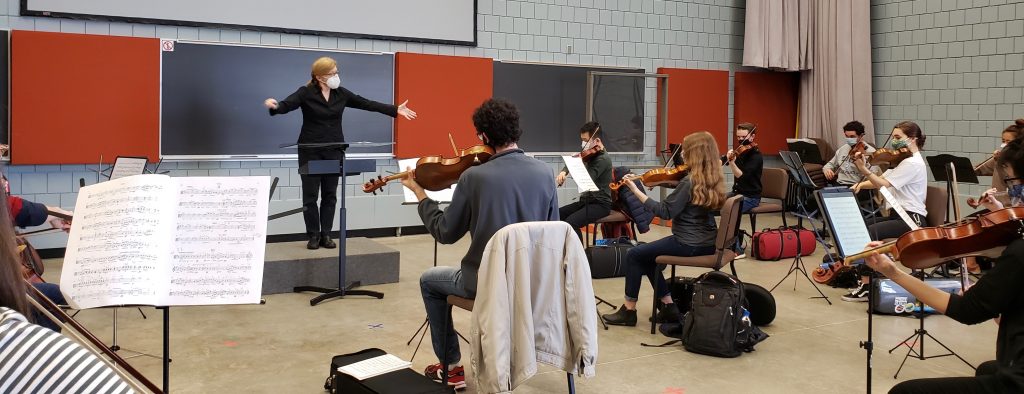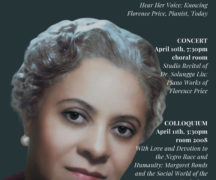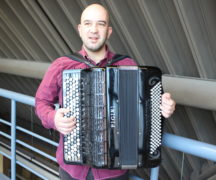By DAVID DUPONT
BG Independent News
COVID-19 protocols have dramatically changed the way the Bowling Green Philharmonia operates.
The orchestra only has strings, and the 50 members have been divided into two smaller chamber ensembles, Orchestra Orange and Orchestra Brown. They rehearse simultaneously in two separate halls.
When they rehearse everyone is at least six feet apart, and rehearsals are split into two parts with a half hour break in between, not for the players to rest, but for the rooms to rest, allowing the air to clear.
Everyone, but the conductor, hauls in their own music stand to rehearsal. The conductor’s stand gets sanitized between uses.
Director Emily Freeman Brown and the graduate conductors hustle between the Kelly Rehearsal Hall and the Choral Rehearsal Hall.
“We’ve made a lot of compromises like everybody else,” Brown said.
She and the students share “the isolation and lack of personal connection” that comes with living during a pandemic And that makes coming together even in these circumscribed conditions all the more special.

“Somehow it’s different now, even more valuable than usual, even more important,” Brown said. “I think the students get a lot out of it. I come out of rehearsal with a sense of joy and fulfillment having worked really hard and accomplished a lot. Those simple things … give you a gratification that’s hard to come by in the pandemic.”
The pandemic protocols also limit live performances with an audience.
On Saturday, Nov. 21 at 8 p.m., the Philharmonia will present a performance featuring both ensembles a livestream on the College of Musical Arts YoTube channel.
“The lucky thing for us as an ensemble is we have a huge repertoire of string music that normally doesn’t get played, and it’s great stuff,” Brown said.
The Orchestra Orange has more young players in it, so it seemed fitting to program Sinfonie No. 12 composed by Felix Mendelssohn when he was 14, just a few years younger than many of the orchestra members.
That ensemble will also perform Ernest Bloch’s Concerto Grosso No. 1, featuring Steven Naylor, a senior piano performance major.

The Orchestra Brown will perform David Diamond’s Rounds for String Orchestra.
“It’s very American,” Brown said. “High energy with a lot of counterpoint, virtuosic. … It’s a real show piece.”
The ensemble will also perform Suite for Strings by Czech composer Leos Janácek. The six short movements each has a distinctive style, Brown said. The music is inspired by the folk melodies and rhythms of Janácek’s homeland.
This is the Philharmonia’s second concert of the semester. The first, Brown said, drew over 1,000 viewers. That accessibility to the concert may be one advantage.
Brown said her students gained much by adapting to the challenges of making music during the pandemic. “I think there are some real more benefits in this experience.”
The students are more self-reliant and independent.
“When I did the first concert the level of cooperation and the discipline of the ensemble was really terrific,” she said.
They also discuss regularly “what it means to stay safe and stay healthy so we can keep on going” and following those precautions outside the confines of the Moore Musical Arts Center, where “we sanitize like crazy.”
If anyone in the orchestra tests positive, the whole enterprise will have to be put on hold.
Several students have had to quarantine because they’ve been exposed to someone with COVID-19. Every rehearsal, Brown said, is on Zoom, so they can watch and make sure they do not miss anything.
Brown also met with students individually over Zoom “to see how they’re holding up.”
“We try to try to keep a kind of sense of community going through the music.”
Next week plans for the spring semester will begin. Brown is planning on performing the challenging “Music for Strings, Percussion and Celesta” by Bela Bartok.
Adding the keyboard, percussion and harp to the strings is possible because they do not project the aerosols that wind instruments do, and performers can be masked.
Beyond that she had hoped maybe winds could be added later in the spring semester, but that doesn’t seem likely at this point.
Now she anticipates it will be next fall before the orchestra can resume with its full instrumentation.
It depends on the vaccine, she said. “Our younger, healthy population will be last on the list to get it. Us old folks will get it sooner. We have to wait and see.”





